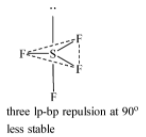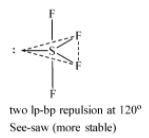
Molecular shapes of
(A) the same with 2, 0 and 1 lone pairs of electrons respectively
(B) the same with 1,1 and 1 lone pairs of electrons respectively
(C) different with 0, 1 and 2 lone pairs of electrons respectively
(D) different with 1, 0 and 2 lone pairs of electrons respectively
Answer
438.5k+ views
Hint: Valence shell electrons pair theory (VSEPR) suggests that the shape of the molecule depends on the total number of electron pairs in the valence shell of the central atom including bonding and lone pairs. Shapes of the molecules can be derived from hybridization and VSEPR theory.
Complete step by step solution:
Let us try to determine the shapes of the molecules given, i.e.
-Shape of
Ground state electronic configuration of S (Z=16):
One electron from the 3d – orbital moves into 3d orbitals so that four electrons can be made available for bonding.
Electronic configuration of S in excited state:
Five orbitals (one 3s+three 3p+one 3d) hybridize to give
As per VSEPR theory, S has 6 electrons in the valence shell. In
-When the lone pair occupies the axial position.

-When the lone pair is occupying one of the three equatorial positions.

The most stable structure of
-Shape of
Electronic configuration of C (Z = 6) in the ground state:
Electron configuration in the excited state:
Four orbitals (one 2s +three 2p) undergo hybridization to give four
Also, according to VSEPR theory, the four valence electrons on C are shared by four F atoms. These

-Shape of
Ground state electronic configuration of Xe (Z = 54):
Outer shell configuration of Xe is
There are four bonds present in
Excited state electronic configuration of Xe:
Six orbitals (one 5s+three 5p+two 5d) hybridize to give
According to VSEPR theory,
Therefore, the total number of electrons pairs available is 6. Out of the six electron pairs, four are bond pairs and two are lone pairs.

Therefore, we can see that the molecular shape of
Hence, the correct option is (D).
Note: Note that if the number of hybrid orbitals is more than the number of atoms or groups surrounding the central atom, i.e. if the total number of electron pairs around the central atom is more than bond pairs, then the shape of the molecule is considered leaving the hybrid orbitals containing lone pairs.
Complete step by step solution:
Let us try to determine the shapes of the molecules given, i.e.
-Shape of
Ground state electronic configuration of S (Z=16):
One electron from the 3d – orbital moves into 3d orbitals so that four electrons can be made available for bonding.
Electronic configuration of S in excited state:
Five orbitals (one 3s+three 3p+one 3d) hybridize to give
As per VSEPR theory, S has 6 electrons in the valence shell. In
-When the lone pair occupies the axial position.

-When the lone pair is occupying one of the three equatorial positions.

The most stable structure of
-Shape of
Electronic configuration of C (Z = 6) in the ground state:
Electron configuration in the excited state:
Four orbitals (one 2s +three 2p) undergo hybridization to give four
Also, according to VSEPR theory, the four valence electrons on C are shared by four F atoms. These

-Shape of
Ground state electronic configuration of Xe (Z = 54):
Outer shell configuration of Xe is
There are four bonds present in
Excited state electronic configuration of Xe:
Six orbitals (one 5s+three 5p+two 5d) hybridize to give
According to VSEPR theory,
Therefore, the total number of electrons pairs available is 6. Out of the six electron pairs, four are bond pairs and two are lone pairs.

Therefore, we can see that the molecular shape of
Hence, the correct option is (D).
Note: Note that if the number of hybrid orbitals is more than the number of atoms or groups surrounding the central atom, i.e. if the total number of electron pairs around the central atom is more than bond pairs, then the shape of the molecule is considered leaving the hybrid orbitals containing lone pairs.
Recently Updated Pages
How to find Oxidation Number - Important Concepts for JEE

How Electromagnetic Waves are Formed - Important Concepts for JEE

Electrical Resistance - Important Concepts and Tips for JEE

Average Atomic Mass - Important Concepts and Tips for JEE

Chemical Equation - Important Concepts and Tips for JEE

Concept of CP and CV of Gas - Important Concepts and Tips for JEE

Trending doubts
JEE Main 2025 Session 2: Application Form (Out), Exam Dates (Released), Eligibility, & More

JEE Main Exam Marking Scheme: Detailed Breakdown of Marks and Negative Marking

JEE Main 2025: Derivation of Equation of Trajectory in Physics

Electric Field Due to Uniformly Charged Ring for JEE Main 2025 - Formula and Derivation

JEE Main Participating Colleges 2024 - A Complete List of Top Colleges

Degree of Dissociation and Its Formula With Solved Example for JEE

Other Pages
JEE Advanced Marks vs Ranks 2025: Understanding Category-wise Qualifying Marks and Previous Year Cut-offs

JEE Advanced 2025: Dates, Registration, Syllabus, Eligibility Criteria and More

JEE Advanced Weightage 2025 Chapter-Wise for Physics, Maths and Chemistry

Hydrocarbons Class 11 Notes: CBSE Chemistry Chapter 9

NCERT Solutions for Class 11 Chemistry In Hindi Chapter 1 Some Basic Concepts of Chemistry

Learn About Angle Of Deviation In Prism: JEE Main Physics 2025




